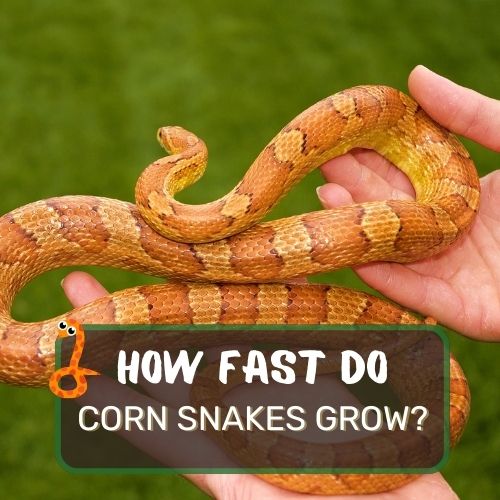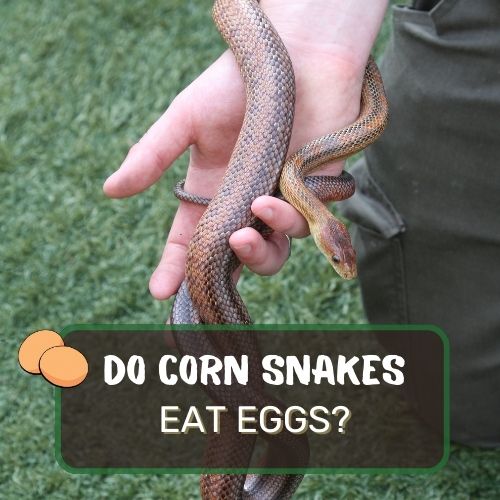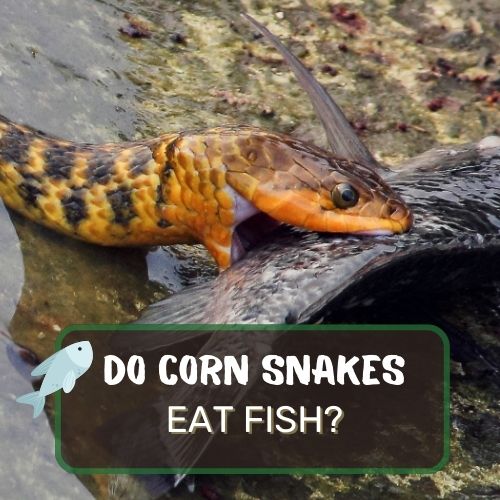Corn snakes, with their vibrant hues and intricate patterns, are a fascination for many. But beyond their striking appearance lies a world of intricate mating rituals and behaviors.
Corn snake mating behavior peaks during spring, from March to May. Females release pheromones, attracting males who then engage in a courtship dance. Male rivalries arise, with dominant snakes securing mating rights. Post-mating, females seek nesting sites and lay eggs.
In this deep dive, we’ll uncover the mysteries of the corn snake’s mating season — from the initial courtship dances and the role of temperature, to the arrival of their young.
Join us as we explore the factors that influence their romance, nesting choices, and the journey to parenthood.
Prepare to be captivated by the world of these serpentine wonders!

Table of Contents
The Timing: When Does the Magic Happen?
Corn snakes, just like us humans, have specific times in their lives when they’re all about the romance. If you’ve ever wondered when these captivating creatures switch on their romantic radios, you’re in for a treat.
The Specific Months They Get in the Mood
March through May are the prime months for corn snake love. This springtime affection isn’t just about flowers blossoming and bees buzzing; it’s the period when corn snakes are most active in their mating rituals.
So, if you see two corn snakes in a seemingly intricate “dance” during these months, you’re probably witnessing some reptilian romance in action!
The Role of Weather in Triggering the Behavior
Ever heard the phrase, “It’s raining cats and dogs?” Well, for corn snakes, a warm spring rain can mean “It’s raining love!” The rise in temperature after a good rain can stimulate corn snakes, making them more active and more receptive to courtship.
The increased humidity coupled with warmth is like nature’s own aphrodisiac for these reptiles.
Age and Size: Do They Matter?
Absolutely! In the corn snake world, age isn’t just a number. Typically, a corn snake reaches sexual maturity between 18 to 36 months of age. The males can be a tad precocious, often ready for romance as early as 18 months.
Ladies, on the other hand, prefer to wait a bit longer, typically around 24 months. Size plays its part too. Females usually wait until they’ve reached a good, healthy size, ensuring they’re fit for the demanding task of producing eggs.
It’s like they have an innate understanding that with great size comes great responsibility!

The Prelude: Behaviors Before the Big Moment
Ah, the anticipation before a big moment. It’s like the butterflies you feel before a first date. For our corn snake friends, it’s a series of fascinating rituals and behaviors that give us a front-row seat to nature’s drama.
So, let’s pull back the curtain and explore this prelude to snake romance.
The Importance of Shedding
Imagine having to change your entire wardrobe before a date, but it’s your skin. Wild, right? For corn snakes, shedding is a part of the mating preparation. Females usually undergo a pre-ovulatory shed, a clear signal they’re ready to mingle.
This shedding ensures they’re in peak physical condition. Plus, let’s face it: new skin? That’s the reptile version of a fresh haircut and a new outfit!
Pheromone Games: How Do They Flirt?
We have chocolates, roses, and sweet text messages. Corn snakes? They have pheromones. As females slither around, they leave a scent trail laced with these chemical messages, signaling their readiness to mate.
Males, with their keen sense of smell, pick up on these signals. It’s their green light, an all-natural, aromatic invitation to the dance of courtship.
How Males Start Their Quest for the Ladies
Now, it’s game time for the males. Once they detect the pheromone-laden scent, they become like detectives on a mission, following the trail intently.
Often, you’ll see them tongue-flicking more frequently, tasting the air, trying to pick up any hint of a receptive female nearby. They become more active, more restless – the chase is on!
The Thermometer Connection: The Role of Temperature
You might be thinking, “Where does the thermostat fit into this love story?” Well, temperature plays a pivotal role in corn snake mating behavior. As cold-blooded creatures, corn snakes rely on external heat sources to regulate their body temperature.
A warm environment boosts their metabolism and energy, making them more active and receptive to mating rituals.
So, when spring’s warmth begins to blanket their habitat, it not only signals the start of the mating season but also ensures they have the energy for the romantic escapades ahead.
In essence, the prelude to corn snake romance is a dance of nature, chemistry, and instinct. It’s a tale of preparation, flirtation, and determination, setting the stage for the main event.

The Mating Dance: Corn Snake Romance
Love is in the air – or more accurately, on the ground, as corn snakes embark on their intricate mating dance. The rituals that these reptiles partake in are nothing short of mesmerizing.
A Closer Look at the Unique Courtship Dance
When a male finally tracks down a female (thanks to those alluring pheromones!), the performance begins. He starts by rubbing his chin along her back, attempting to align their bodies.
As they slither alongside each other, it appears as a synchronized dance – intimate, deliberate, and utterly fascinating to watch.
The Fierce Competition Among Males
However, it’s not always a two-snake tango. Often, multiple males can pick up on a single female’s scent, leading to quite the competition. These rivalries involve a lot of intertwining, pushing, and even “wrestling” to deter competitors.
It’s a high-stakes game, with the strongest and most determined male usually winning the privilege to mate.
How Long Does the Action Last?
Once the male establishes his dominance and the female is receptive, the actual mating can take anywhere from a few minutes to several hours. It’s not a rushed affair – these reptiles ensure they invest time in their romantic encounters.

The Afterparty: Post-Mating Dynamics
After the dance is where things get even more intriguing!
Female Behavior After the Tango
Post-mating, the female gets into serious business mode. She’ll start searching for the ideal nesting site to lay her eggs, often becoming more reclusive. This nesting behavior is a sign she’s preparing for the next big step: motherhood.
What Do Males Do After the Dance?
Males, on the other hand, don’t have any post-mating parental responsibilities. Instead, they’re off, potentially searching for other females to mate with. For them, the mating season is a time of adventure, exploration, and spreading their genetic material as widely as possible.
The Pregnancy Timeline
After the mating encounter, female corn snakes carry their eggs for about a month before laying them. These eggs will then incubate for approximately 60 to 65 days before hatching, depending on the temperature.
Warmer conditions can speed up the incubation, while cooler temps might prolong it. It’s a waiting game, but the eventual arrival of baby corn snakes is worth the anticipation.
From the seductive dance to the post-mating dynamics, the world of corn snake romance is a blend of strategy, competition, and nature’s rhythm. It’s a reminder of the fascinating behaviors that unfold in the animal kingdom, right under our noses.

Egg Matters: Laying and Baby Snake Arrival
The story of the corn snake romance doesn’t end with the mating dance. In fact, the next chapter is perhaps even more captivating. As the curtain rises, our spotlight shifts to the world of egg laying, nesting, and the highly anticipated arrival of baby corn snakes.
House-Hunting: Where Do They Nest?
For a corn snake mama, real estate is everything. She’s on the lookout for the perfect spot to lay her eggs. This isn’t a hasty decision. Humidity, temperature, and safety are paramount.
Often, she’ll choose secluded spots – under logs, in burrows, or within leaf litter. Think of it as a cozy, concealed nursery where she can ensure her future offspring will have the best start in life.
The Egg-Laying Ceremony
Once the ideal nest site is selected, the female embarks on her egg-laying journey. This is no minor feat. Depending on her size and health, she can lay anywhere from 10 to 30 eggs. These eggs are usually elongated, leathery, and soft.
As she lays them, she meticulously arranges them, ensuring they’re optimally positioned.
Temperature’s Pivotal Role in Egg Hatching
Nature’s incubator, aka the environment, plays a massive role here. The temperature of the nest will influence not just the speed of development but also the gender of the hatchlings.
Warmer temperatures often produce more females, while cooler temps lean towards males. It’s a delicate balance and a true testament to nature’s intricacies.
Counting Days: How Long Before the Little Ones Arrive?
Tick tock, tick tock. The countdown begins right after the eggs are laid. On average, it takes about 60 to 65 days for the baby snakes to hatch. This duration can vary slightly based on environmental factors.
And when the day finally comes, tiny replicas of their parents, fully independent and ready to explore, break free from their shells. It’s the grand finale to a captivating saga.
From start to finish, the lifecycle of corn snakes is a journey filled with drama, strategy, and nature’s magic. Every phase, from mating to hatching, offers a glimpse into the wonderful world of these serpentine creatures.
Conclusion
You’ve journeyed through the mesmerizing world of corn snake mating behaviors, from their captivating courtship dances to the meticulous care of their offspring.
These reptilian wonders, influenced by the rhythm of seasons and temperatures, give us a window into nature’s intricate choreography. As you continue exploring the vast world of animals, remember that even in the tiniest details, nature never ceases to amaze.
Keep your sense of wonder alive, and you’ll always find something extraordinary in the ordinary. Happy exploring!
Frequently Asked Questions
Ah, the burning questions! Let’s dive into the most commonly asked queries about corn snake mating season.
How Long is Corn Snake Mating Season?
The mating season for corn snakes typically spans spring, from March through May. It’s like their own version of spring fever, lasting roughly three months.
Do Corn Snakes Get Aggressive During Mating Season?
Indeed, male corn snakes can become more aggressive, especially when competing for a female’s attention. These “snake battles” are their way of establishing dominance. However, it’s usually more about posturing and less about actual harm.
Do Corn Snakes Eat During Breeding Season?
While corn snakes do eat during breeding season, their appetite might decrease. It’s not uncommon for females, especially, to eat less as they prepare to lay eggs. It’s all about prioritizing romance and reproduction during this time!




0 Comments